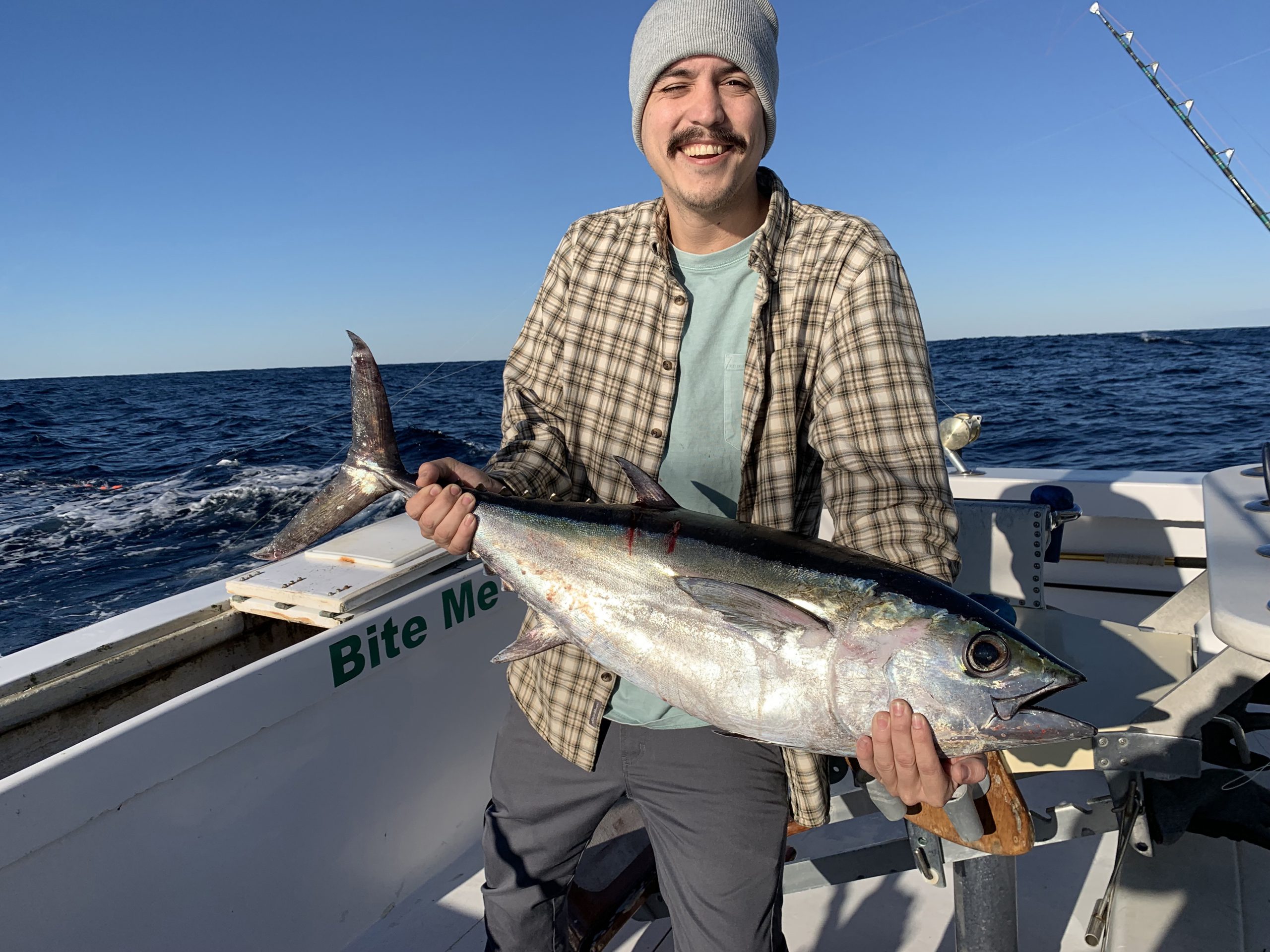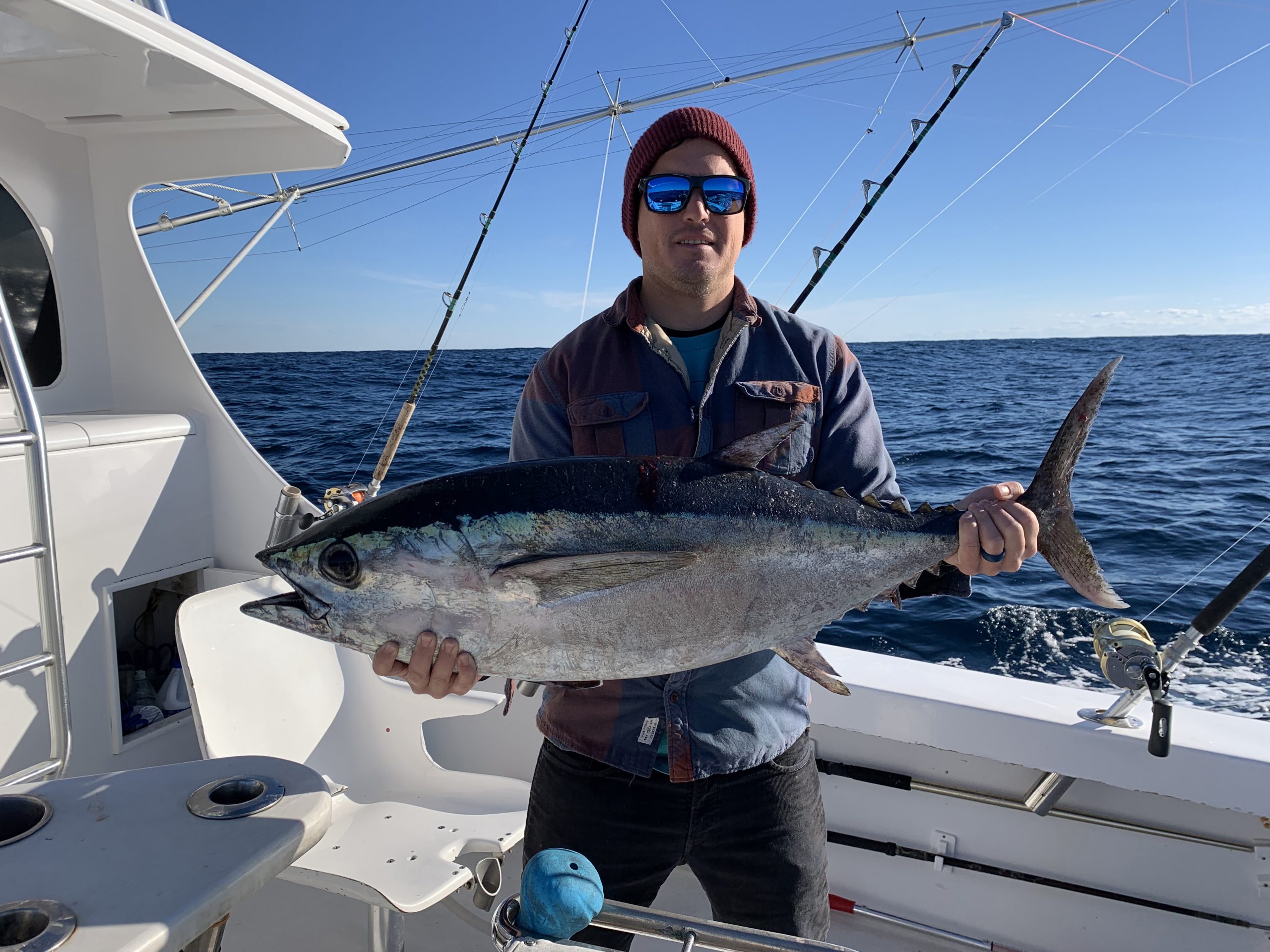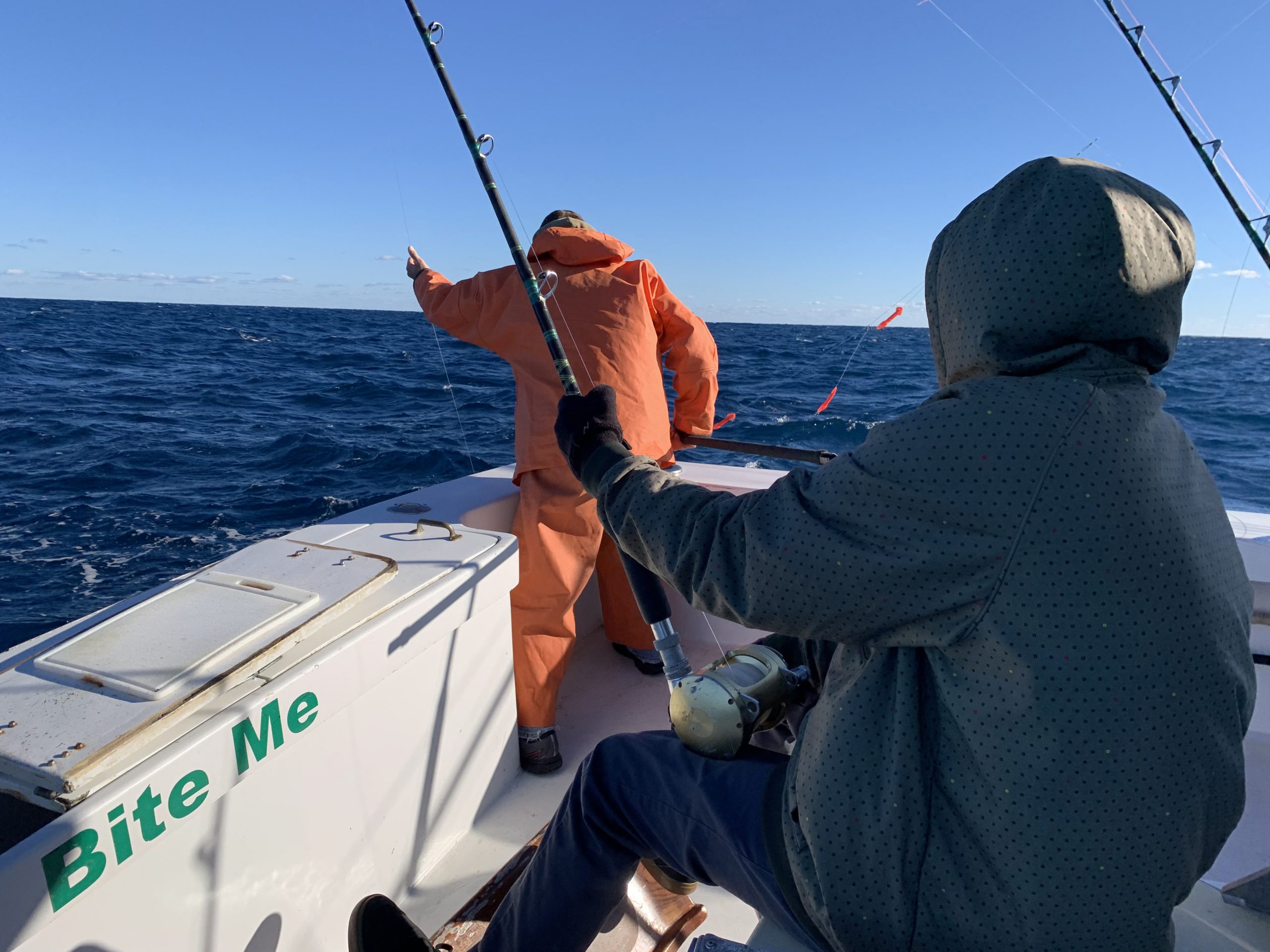Guide Times – On the Hot Seat with Bite Me Sportfishing
Jay told me, as in Capt. Jay Kavanagh of Bite Me Sportfishing out of Hatteras, that the fishing this fall had been more scrappy than usual, but since our original plan to meet in September for the Oregon Inlet white marlin bite had been canceled due to a lack of white marlin, and then when two fall trips were pushed due to inclement weather, I figured a scrappy, late November blackfin trip was better than no trip.
We set a date, and then I went to work putting together some friends to join in. The first guest was an easy decision. Rocky Damico, who writes all the fishing reports for every issue of Fisherman’s Post, had been out of town with his wife since the early days of Covid, as her temp job as a travel nurse paid something like a thousand times better than his writing gig for me, so Rocky and I were long overdue to do a fishing trip together.
Finding a third proved to be a bigger challenge, now that we were in the busy period between Thanksgiving and Christmas. Luckily, Rocky spent some time living in Nags Head, and even luckier, one of the better friends he made out there was not only able and willing, but excited for any adventure, especially a Gulf Stream trolling trip with one of the top captains in the Hatteras fleet.
Rocky and I picked up Corey Culpepper (and his Movember mustache) in the Pirate’s Cove parking lot at 9:30 at night, about an hour after he got off his shift at Blue Water Grill, and we headed down the island. We drove through Rodanthe’s new traffic circle that is lined with barrels until it and the Jug Handle Bridge are completed, then kept going without stopping at Avon’s Food Lion that was closed tight since we were after 10:00 pm in the offseason, passed Buxton’s lighthouse light circling, and made our way to Breakwater’s Fisherman’s Quarters in Hatteras Village for an after-hours check-in.

Corey Culpepper, from Nags Head, and his mustache hold up the first fish of the day–a 20 lb. blackfin caught on a ballyhoo with a purple and crystal sea witch. He was fishing with Capt. Jay Kavanagh and Mate Jeffery Midgett of Bite Me Sportfishing out of Hatteras Harbor Marina.
We were three dudes in a modest but clean and comfortable hotel room, and after settling in, we had about 5 hours to get some sleep before it was time to make the 30-second drive to the boat slip.
Colors were already visible off the stern of the boat as we headed west out of Hatteras Harbor Marina to make the marked and gradual turn through the sound and past the north side of Ocracoke to head out of the inlet, and in the time it took to clear land, those same colors, now a little higher in the sky and definitely more vibrant, were off the bow for the hour-ish run to our fishing grounds for the day, the area around Diamond Shoal Light.
Rocky’s and Corey’s job was to crank on fish, my job was to take notes and photos for this article, Jay’s main responsibility was to find fish (forgive my oversimplification), and the burden of the workload, in my humble opinion, fell on Jay’s new mate—Jeffery Midgett.
I say “new,” but Jeffery’s been working on and off with Jay for about 20 years.
Our first stop was in about 300’ of water. We were fishing behind the rocks of Diamond Shoals, a rock pinnacle that goes on for something like 14 miles and is perhaps a mile wide.

Rocky Damico, of Fisherman’s Post, with a 25+ lb. blackfin caught on a blue and white sea witch in the area of Diamond Shoal Light. He was fishing off Hatteras with Capt. Jay Kavanagh of Bite Me Sportfishing.
“It’s basically a rock plateau that has some stubs on it and some shipwrecks on it,” Jeffery told me. “The Continental Shelf drops off the back. The Gulf Stream shoves up, and the Labrador shoves down. The Gulf Stream makes eddies off it, and it seems like these blackfins are always up here.”
Blackfins were our target species, but it’s the Gulf Stream, so there’s always a chance of other species. In late November, those other species would mostly be yellowfins and wahoo, but we even had some cut bait at the ready in case some of the late season mahi the fleet had been seeing appeared.
Jeffery, self-described as one of the most laid-back guys you’ll ever fish with, was more than happy to talk into the voice recorder app on my phone, so I asked him to describe our starting spread for blackfins.
“We have a flat line with a blue and white sea witch with 80 lb. fluorocarbon,” he started, pointing to the left-hand side. “There’s a marlin teaser on our left teaser, and it looks like a yellowfin. Sometimes a yellowfin will think it’s another yellowfin coming up and eating, so they’ll come up around the flat line.”
“The short rigger on this side,” he continued, “is called a ‘string of shit.’ It basically has four squids on it on 150 lb. mono, and then about 5 feet behind the squids, it has a blue and white sea witch. The left long is a purple and crystal sea witch on 80 lb. fluorocarbon.”
“On this side,” he said, now pointing to the right, “will be a planer with a red and crystal bullet Hawaiian Eye. Then you have a regular pink squid teaser with a bigger ballyhoo behind it. On the short right is a, well it changes, but today it’s a piece of wire. In case a marlin or something comes in there, I can switch that around to wherever we need to go with it, and it has some sort of Hawaiian Eye, usually like a bullet head or a chugger head. Behind that, there’s a green and crystal sea witch on 80 lb. fluorocarbon.”
We were now both looking straight up at the bridge as Jeffery described the last two rods.
He finished, “Down the middle is a blue and white sea witch with 80 lb. fluorocarbon, and behind that is another blue and white sea witch with 80 lb. fluorocarbon.”
It didn’t take long at all for our first bite of the morning. Rocky and Corey are nice guys and good friends, so I’m sure they politely argued a little about which one of them would be up first when we got a bite, each wanting to defer to the other. However they decided, when the left long line popped (purple and crystal), Corey made his way to the chair.
If I knew Corey better, this would be the part of the article where I made fun of just how hard he struggled to bring that blackfin into gaffing range. I would be fair and mention that his fish would prove to be a citation blackfin, weighing in at over 20 lbs. back at the dock, but still there seemed to be way too many pauses, way too much heavy breathing, and certainly too much sweat for a 40-ish degree morning, even with that mustache.
Jeffery picked up immediately that he had a novice angler in the chair, so he coached Corey until the fish was successfully in the fish box. While Rocky and I fist bumped Corey in congratulations, Jay and Jeffery quickly got the spread back out and the boat up to trolling speed.
Our first fish went so smooth that I thought it another opportunity to ask Jeffery to talk into the recorder. I asked him about how he likes to run the cockpit once he has a fish on, especially when he has an angler in the chair with little experience.
“I first get them in the chair and then tell them to keep the rod at a 45,” he shared. “I tell them not to get all jerky up and down with the rod because the boat’s pulling and you’re not going to gain anything. You’re just going to wear yourself out.”
We had been trolling at 7 knots, and when that first fish popped the clip, Jay had kept the boat moving forward at 7 knots until Corey was in the chair and had started to crank. The hope in staying at trolling speed was multiples, and the reason for always keeping the boat in gear after backing down off trolling speed was to “swim” the fish to the boat
“The only time you should be getting the rod up and down,” he continued, “will be if a fish is right underneath the boat and you just have to pull them up. I tell you to lower your rod tip, then pull up and crank down, pull up and crank down.”
Jeffery seemed to welcome more questions, and he was basically writing my article for me, so I asked him about his philosophy in handling the spread when a fish is on.
“I want to get my short rigger in first, the one on the side of the boat with the fish so it doesn’t dig across,” he started. “Then I’ll go clear my planer. When tuna fishing, you want to leave as much stuff out as you can, but I definitely want the planer up. As the fish gets closer and closer, I may have to pull more lines.”
How about when the fish gets close?
“When the fish gets close, I have them drop the rod tip so the crank-on swivel can come on easier, and if I have to let the line go because the fish makes a run, the line doesn’t have as much to get caught up on as it goes back off. I can’t ever wrap on the 80 lb., but I can pinch it and feel it stretch. A couple of times I may have to let go a little bit, but then I’ll pull it back.”
How about gaffing the fish?
“You don’t ever gaff when the fish is down below the water. As soon as you get their head up, they have no control anymore, so as soon as you get their head up, you can gaff them. I also tell the angler to stop cranking. Tunas don’t matter as much, but if it’s a wahoo, they’ll just keep cranking the fish right on top of them.”
What other guidance do you often have to give new anglers in the chair?
“Always grab the rod with your left hand and grab up on the rod. Then use your thumb to wind the line back and forth so the line levelwinds.”
Anything else?
“Sometimes we get people, such as little kids, and they’ll have their dad hold the rod for them. The kid will want to let go of the rod with their left hand and grab the crank with both hands and crank across. That’s one of the biggest no-no’s because you can hit the drag and free spool it.”
Corey had started early in the fight to “get jerky up and down with it,” but he quickly followed instructions when advised otherwise. I’m also happy to report that not only did he successfully use his thumb to guide the line back onto the spool, but he also never asked Rocky or I to hold the rod, nor did he ever try to reach over with two hands to crank on his fish.

Corey Culpepper sits in the chair while Mate Jeffery Midgett coaxes a blackfin into position for the gaff. The tuna was hooked in 300′ of water while fishing with Capt. Jay Kavanagh of Bite Me Sportfishing.
This next part of the article is fact and contains no judgement in any way: Rocky was up next. His fish hit the long line (out further than Corey’s fish) and was bigger than Corey’s (weighing in at 25+ lbs.), but Rocky brought his fish to the boat in about a third of the time that it took Corey. No ongoing pauses in reeling. No heavy breathing. No sweat.
Again, no judgement—just facts.
Capt. Jay Kavanagh, of Bite Me Sportfishing out of Hatteras Harbor Marina, has the experience and thirst for hunting pelagics, as well as a great mate, to put you on your own target species, whether that’s spring tunas and mahi, summer mahi and billfish, or fall tunas, wahoo, and billfish (and that’s an abbreviated list of possibilities).
You can find out more about Bite Me Sportfishing, including fishing reports and booking information, by visiting www.fishbiteme.com.
Pick your fishing day, gather your group, decide who is going to be the first in the chair, and then hope you’ve invited friends that are nicer than me—or at least hope you didn’t invite friends that have several media platforms for telling everyone how you did in the chair.
